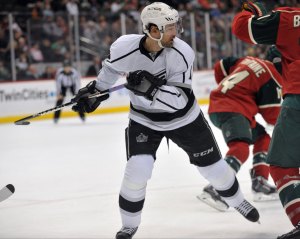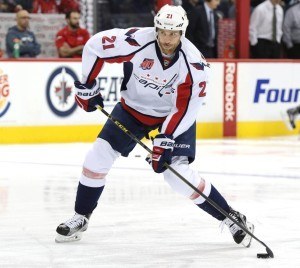Two things happened with the Washington Capitals’ signing of Justin Williams Wednesday. The team filled a hole at right wing among its top six that has existed for quite some time while also creating a bit of a glut among the team’s veteran third-line caliber players.
Well, the third-line dam broke in a big way on Thursday with the news that the Caps had traded one of

their likely bottom six, Troy Brouwer, along with goaltending prospect Pheonix Copley and a 2016 third-round pick, for St. Louis Blues winger T.J. Oshie.
With Williams and Oshie in the fold now there is little doubt that each likely will land on one of the top two lines. In all probability they will either skate with superstars Alexander Ovechkin and Nicklas Backstrom on the first line or among the second trio, possibly with promising young forwards Evgeny Kuznetsov and Andre Burakovsky – or maybe veteran Marcus Johansson.
Before the Oshie deal it looked as though Williams was either going to skate as the right wing on the top line or on the second line with Johansson and Kuznetsov. In the latter scenario Burakosvky probably would have moved to the top group. Now it appears as though he might compete for the third spot on the second line with countryman Johansson, who is coming off a year in which he tallied career bests of 20 goals and 47 points.
And on the Second Line
Sticking on the second line might be an uphill battle for Johansson, though, based on comments by Washington General Manager Brian MacLellan after the Williams signing: “In my mind, I’d like to play him with Burakovsky and Kuznetsov because I think he’d have a big effect on them. But the first line could be a great fit, too. I think Barry {Trotz} will just try it out and see what works chemistry wise and what’s best for our team.”
Burakovsky, the 23rd pick of the 2013 draft, started out last year with a bang by scoring on opening night against Montreal in his first NHL game. He spent the season bouncing back and forth between D.C. and Hershey, finishing with nine goals and 13 assists in 53 NHL games to go along with three goals and four assists in 13 AHL contests.
Burakovsky showed flashes of his smooth and fast skating, quick release and good vision during his initial NHL stint, but also seemed lost at times and frequently was outmuscled. He returned to the lineup for good in the opening round of the playoffs after Eric Fehr went down with a shoulder injury and was more effective in the hard areas and a better fit for Trotz’ system. Burakovsky contributed two goals and an assist in 11 playoff games and then returned to the Bears for the Calder Cup Playoffs after the Caps were eliminated and netted a goal in his first game back.
Johansson, who won’t turn 25 until the opening week of the season, had a breakthrough year in terms of consistency in 2014-15 and has developed into a reliable scoring threat and a solid two-way forward. He has seen considerable time as both a penalty killer and a member of the Caps’ first and second power-play units. Given his two-way capabilities and tremendous speed he might be a more logical choice to take on a third-line role over Burakovsky, who at this point is more of a skill-dependent player and is still learning to play effectively in all three zones.
First Things First
Of course before we can change pencil to ink in the Caps’ lineup MacLellan must get RFAs Kuznetsov, Johansson and Braden Holtby to actually sign on the dotted line. “Our main focus has been on the RFAs, and it continues to be a priority,” he said. “Holbty, Kuznetsov and Johansson are priorities. We want to get them signed.”
Once the RFAs are inked, training camp will determine exactly where all of the top-nine pieces fit. Williams has the versatility and skill set to play on any of a team’s top three lines. “It’d be an absolute treat to have players of that playmaking ability making passes to you,” Williams, referencing Backstrom and Ovechkin, told reporters in a conference call Thursday.
His puck possession numbers and grit, along with his ability and willingness to pursue and handle the puck in high traffic areas, would seem to be the perfect complement for young skill players Burakovsky and Kuznetsov. And Oshie, who has averaged 20 goals and 58 points the past two seasons – including a career-high 60 points last year – figures to have the skill and playmaking ability to finally end the revolving door at right wing on the top line. Last year nine different right wings skated with Ovechkin and Backstrom.
The Bottom Six
Assuming that the top-six situation is at least resolved in terms of personnel at this point, the more unsettled situation appears to be among the bottom six. Washington still has a plethora of players – veterans and younger prospects – capable of taking on third-line minutes. But someone has to be the odd man out.
Immediately following the season MacLellan said that it is time for third-year bruiser Tom Wilson to take the next step and contribute more than inconsistent fourth-line minutes and the seemingly nightly scrap. MacLellan said he thinks Wilson has the ability to eventually play among the top six, but clearly the Caps have bought time to be able move the youngster along slowly and let him mature on the third line. It appears ikely that they will commit to him at that spot this season unless the experiment proves to be a disaster.

Assuming that Johansson drops to the third line to play with Wilson, Washington would be left with old standbys Brooks Laich and Jason Chimera competing for the other third-line spot. Laich has the advantage of being able to play wing or center – but also carries a hefty $4.5 million salary (and a $4 million price tag for 2016-17). Chimera still possesses blazing speed and plays with an edge, but neither he nor Laich have been consistent offensive threats. And the fact that Johansson also can play center effectively negates Laich’s advantage there.
Chimera topped out with a career-best 42 points in 2013-14 before falling to earth and putting up just 19 last year. He was solid in the playoffs, though, tallying four goals and three assists in 14 contests and seeing some top-six time. Laich, meanwhile, registered seven goals and 13 assists in 66 regular-season games, his most appearances since 2011-12, and then contributed just two points in 14 postseason contests.
Given the consistency of his effort and the playoff showing it is very possible that Chimera will end up on the third line as the season opens, with Laich dropping to play on the fourth with Jay Beagle and Michael Latta. A pair of speedsters such as Chimera and Johansson on the same line with a physical presence like Wilson is an intriguing combination offensively and on the forecheck. And if that’s how things play out, it’s not all bad news for Laich, a dependable two-way player who has three 20-goal seasons to his credit and would most likely assume his usual role as one of the team’s top penalty killers.
Also waiting in the wings to make a push for an NHL roster spot are recently re-signed Stanislav Galiev, former U.S. Junior Team captain and Miami of Ohio star Riley Barber and Liam O’Brien, who had a cup of coffee with the Caps a year ago. Up until Thursday you could make a case for any of the three pushing for a roster spot in camp, but after MacLellan’s moves to bring in Williams and Oshie it’s unlikely that we will see them in D.C. in a regular role this year.